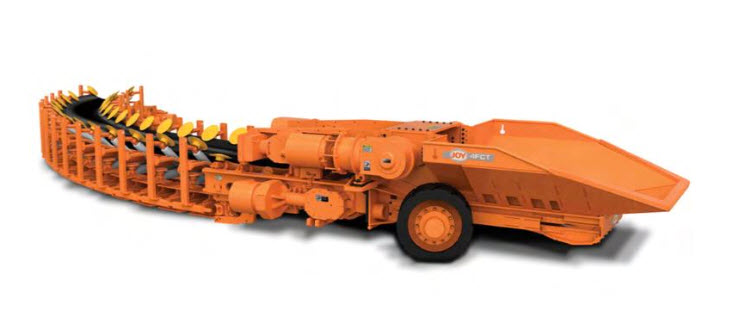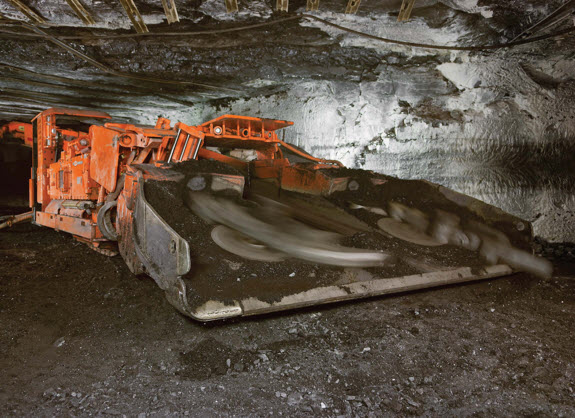5.3.3: Batch versus Continuous Haulage
Batch haulage is the term given to the discrete movement of material. Shuttle cars, rail cars, hoist skips, and trucks are common examples of batch haulage. Conveyors and hydraulic slurry are two examples of continuous haulage. Over the years, the goal has been and continues to be, the replacement of batch with continuous haulage. And, we’ve been reasonably successful in many cases.
Rail haulage has been replaced with belt conveyors in many mines. Moving trains around the mine, ensuring a supply of empty cars where they are needed while moving loaded cars out of the mine and doing so over limited track networks has been a daunting challenge. Gone are the days when rail haulage was used in open-pit mines and most coal mines. However, there are still applications where it is the haulage of choice. If you have to move enormous volumes over a great distance, it is a viable choice. Probably, you will find the greatest use of rail in very deep underground metal mines.
Skip haulage or hoists have been replaced in many mines by driving slopes and using rail or belt haulage, with the latter being more prevalent today. In shallower underground mines, vertical belts are being used to replace hoisting up shafts. Still, in many mines, there is no reasonable alternative to a hoist. Deep mines, thousands of feet below the surface, rely solely on skips to remove the ore. Mines at which there is no ability to put in a slope, and which are a bit too deep for vertical belts, will continue to utilize hoists.
Truck haulage continues to be prevalent in surface mining because they can transport huge volumes of material economically from the working face to the processing plant. Truck haulage is also common in underground hardrock mines that have a slope or ramp to the surface so that the material can be transported from the working face to the plant. Oversize material is generally not a problem for trucks, but is a big problem for conveyors. Abrasive rocks are not a problem for trucks, but are for conveyors.
In certain open pit mines, which are very deep, the time required for a haul truck to make its way out of the pit can become excessive. In these cases, high angle conveyors can be used to good advantage.
The haulage examples that I’ve described so far can be categorized as outby haulage, i.e., the part of the materials handling system used to transport the material through the mine and to the plant. This distinction may seem odd. In the case of truck haulage, as we just discussed, the truck is loaded at the face and then travels to the plant. However, there are many examples, particularly in underground mines, where there is an intermediate form of materials handling. In these instances, the ore at the face is loaded onto one form of materials handling, transported a short distance, and then transferred to the outby haulage system for the trip out of the mine and to the plant.
It is in the form of intermediate haulage that we encounter our old friend, the shuttle car. The LHD would be another example. And this brings us back to that question: what can we do about that weak link, the shuttle car?
The area around the active working faces is very dynamic. It is difficult to construct semi-permanent infrastructure in this area; and it is for this reason that intermediate haulage has evolved. If we are to make an improvement, we would need a conveyor belt that was mobile, i.e., it could travel around the working faces, following the continuous miners or loaders. Prototypes of such systems have been built for use in underground metal mines to replace LHDs, but they have met with little success. In the case of soft rock applications, and notably coal and salt, there are commercially available technologies to meet the need, in specific circumstances. Here is a picture of a commercially available flexible conveyor. These units can turn corners and can be piggybacked to provide a continuous path of several hundred feet between the continuous miner and the section dump point. Recall that it is at the section dump point where the coal is fed onto the main or outby conveyor belt. This technology is being used successfully in some salt mines, but has found limited application in underground coal mines. For reasons that lie beyond the scope of this discussion, they work best in shallow mines with small pillars; and that is a small subset of all underground coal mines.
But not to despair, there is one other option in limited but successful use.
Rather than having the continuous miner load into a shuttle car, and being captive to the availability of shuttle cars, what if we allowed the continuous miner to dump onto the mine floor? Sounds crazy, right? But, not really. We could use a loading machine to clear away the pile, and trust me, loading machines can load a shuttle car very quickly. So, the shuttle cars would queue up for loading, but if there were a delay, the continuous miner would be able to continue mining without incurring a delay. Sure, the pile behind the machine might grow rather large, but no worries. The loading machine will get rid of it quickly. As you can see in the picture, the loading machine has a larger set of gathering arms than the continuous miner. The operating principle is the same, however: the gathering arms pull the coal into the belly of the machine and onto the chain conveyor.
And now, having addressed the quest for continuous, we not only understand the technology options, but we’ve become more familiar with the key concepts of availability, system delays, and batch versus continuous haulage.
There is one final unit operation to study, and one that is a huge part of most mining methods. It’s generally one of the more popular topics among mining students as well: explosives and blasting!

